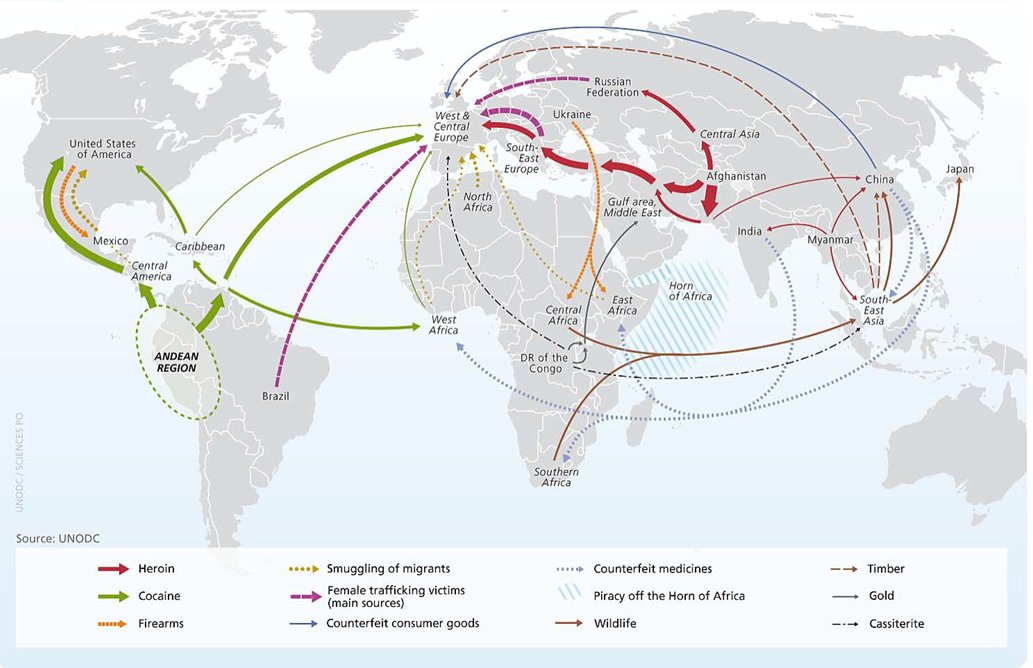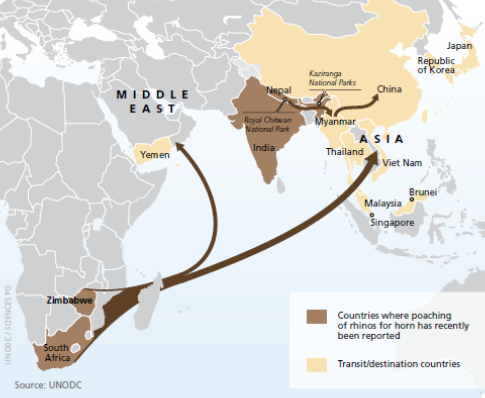- How much organized crime is there?
- Alternative ways to measure organized crime
- Measuring product markets and flows
- Risk assessment
- Key concepts of risk assessment
- Risk assessment of organized criminal groups
- Risk assessment of product markets
- Risk assessment in practice
- Summary
- References
Published in April 2018
Regional Perspectives: Pacific Islands Region - added in November 2019
Regional Perspective: Eastern and Southern Africa - added in April 2020
This module is a resource for lecturers
Measuring product markets and flows
An alternative method has been developed to assess organized crime, given the problems of measurement and the need for specific guidance for interdiction and prevention efforts. This method attempts to measure organized crime by assessing product markets and flows.
In 2010, UNODC published The Globalization of Crime: A Transnational Organized Crime Threat Assessment, which offered for the first time a global overview of illicit product markets and flows. Multiple other reports subsequently have been developed by UNODC that focus on the transnational organized crime problems in specific world regions to allow for more specific guidance (UNODC, 2013).
The scope of this global assessment effort was vast, and it is best illustrated by a single map, depicted in Figure 5.1.
Figure 5.1 Global Flows of Transnational Organized Crime

Source: UNODC, 2010, p.2.
Figure 5.1 depicts the report's findings in tracing the sources of each illicit product through transit points and to its ultimate destination, where it is consumed or exploited. The data on which the report is based are taken from existing information from police arrests, seizures, court records, media reports, NGO reports, and experts on the ground in many different countries who have first-hand exposure to these illicit product markets. The markets included in the report are trafficking in persons, smuggling of migrants, cocaine and heroin trafficking, firearms trafficking, trafficking in wild flora and fauna, counterfeit products, maritime piracy, and cybercrime.
This global analysis helped to change the perspective on organized crime from a focus on specific organized criminal groups and individual activities to illicit product markets from sources to destinations. The report highlights the flows that are exploited for profit by organized criminal groups. As an example, flows from sources to destination countries for the illicit market in rhino horn were assessed, based on known cases and reports from local authorities, NGOs, and the media in these regions. This flow is illustrated in Figure 5.2.
Figure 5.2 Tracing Flows of Illicit Rhino Horn Trafficking

Source: UNODC, 2010, p.155.
The findings of the global report The Globalization of Crime: A Transnational Organized Crime Threat Assessment were largely confirmed in regional reports, which focused more intensely on smaller geographic areas. For example, the transnational organized crime assessment report on Eastern Africa, published in 2013, focused on migrant smuggling, heroin trafficking, ivory trafficking and piracy. The West Africa report of the same year focused on drug trafficking routes, migrant smuggling, firearms trafficking, falsified medical products, and piracy. The report on East Asia and the Pacific, also published in 2013, covered a broader region and included assessments of trafficking in persons, migrant smuggling, drug trafficking, trafficking in environmental resources, counterfeit goods and falsified medical products (UNODC, 2012; UNODC, 2013; UNODC, 2016). Major findings from across the different product markets are highlighted below:
- Groups versus markets: Organized criminal groups have become less important than the illicit markets they exploit. There have been some significant law enforcement successes against organized criminal groups in different regions of the world. These have resulted in major drug, human trafficking, counterfeit product, and cybercrime prosecutions that have disrupted major groups and criminal networks. Nevertheless, the demand continues, so new criminal entrepreneurs emerge to exploit the illicit market.
- Prosecution and illicit activities: Successful intervention and prosecution strategies aimed at organized criminal groups do not stop the illicit activities on which they profited. If the dynamics of the illicit market (supply, demand, regulation and enforcement capacity, and competition) are not also addressed, others will continue the illicit activity.
- Individual responsibility and illicit markets: Police officers, investigators and prosecutors are trained to make cases against individuals and groups in their jurisdiction, so their focus is on individual responsibility for a past action. They are not trained, and do not have authority, to interrupt markets and flows, which exist independent of whoever might be exploiting them. As a result, the focus on interdiction must be much more than building cases against individuals; it must be a broader effort that also reduces supply, demand, and criminal markets more generally.
- International product flows: Most product flows exploited by organized crime are international in nature with the source of supply and the demand often in different countries or even different continents while criminal legislation as well as statistics on arrests and prosecutions are more often than not circumscribed by national boundaries. Therefore, a focus on international cooperation and standardized procedures for tracking illicit product flows and cases is needed in order to be more successful against organized crime.
The effort to examine product flows and the influences of supply, demand, competition, and law and enforcement capacity has gained traction in the professional and academic communities as a useful way to capture the nature and extent of various types of transnational organized crime (Albanese, 2008; Bisogno, 2016; Castle, 2008 Klerks, 2007; Mešsko, Dobovšek, Kešetovic, 2009; Midgley, Briscoe and Bertoli, 2014; Savona, 2006; Savona and Stefanizzi, 2010; Savona, 2014; Vander Beken; 2004; van Dijk, 2007). Risk and threat analyses based on careful examination of individual product markets is a promising approach to capturing the magnitude of organized crime in different world regions.